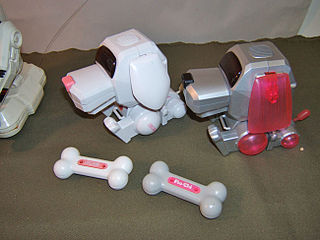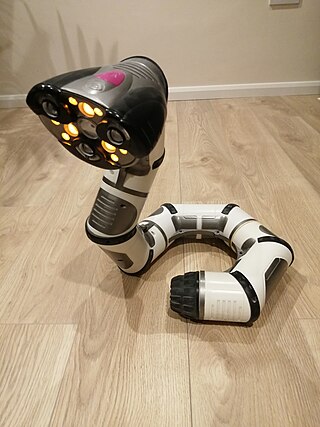
Lego Mindstorms is a discontinued line of educational kits for building programmable robots based on Lego bricks. It was introduced on 1 September 1998 and discontinued on 31 December 2022.

Mark W. Tilden is a robotics physicist who produces complex robotic movements from simple analog logic circuits, often with discrete electronic components, and usually without a microprocessor. He is controversial because of his libertarian Tilden's Laws of Robotics, and is known for his invention of BEAM robotics and the WowWee Robosapien humanoid robot.
BEAM robotics is a style of robotics that primarily uses simple analogue circuits, such as comparators, instead of a microprocessor in order to produce an unusually simple design. While not as flexible as microprocessor based robotics, BEAM robotics can be robust and efficient in performing the task for which it was designed.
WowWeeGroup Limited, is a privately held, Hong Kong–based Canadian consumer technology company.
An entertainment robot is, as the name indicates, a robot that is not made for utilitarian use, as in production or domestic services, but for the sole subjective pleasure of the human. It serves, usually the owner or his housemates, guests, or clients. Robotic technologies are applied in many areas of culture and entertainment.

i-Cybie (爱赛比) is a robotic pet that resembles a dog. It was manufactured by Silverlit Toys Manufactory Ltd Hong Kong from 2000 to 2006. i-Cybie was developed for commercial distribution by Tiger Electronics. Outrageous International Hong Kong distributed the electronic pet from 2005 to 2006. The i-Cybie robotic dog responds to sound, touch, movement, and voice commands. The toy robot can autonomously recharge its batteries using a special docking station. I-Cybie was the first mass-produced toy that used advanced voice recognition technology.

Poo-Chi, one of the first generations of robopet toys, is a robot dog designed by Samuel James Lloyd and Matt Lucas, manufactured by Sega Toys, and distributed by Tiger Toys. Poo-Chi was released in 2000 and discontinued in 2002.
The Robosapien V2 is the second generation of Mark Tilden's Robosapien robot. It is nearly twice the size of the original robot, standing around 1.85 feet (56 cm) tall. Instead of the original caveman grunts, the V2 can speak a large list of pre-recorded phrases. It has infrared and basic color recognition sensors, grip sensors in its hands, touch or contact activated hand and foot sensors, and sonic sensors. For movement, the V2 has an articulated waist, shoulders, and hands giving him a variety of body animations.
The Roboreptile is a toy robot by WowWee. The Roboreptile has infrared and sound sensors, and is able to autonomously explore its environment while avoiding obstacles. It can also operate in different modes where it simulates behaviors of real animals. It is able to rear up on its hind legs and attack. Roboreptile was released in China on the 28 April 2006 and to the rest of the world later that year. It is superficially similar to a theropod or a prosauropod dinosaur but being quadrupedal it's better equated to a silesaurid or a monitor lizard.

The Alive Chimpanzee is produced by WowWee Alive, a division of WowWee Ltd. The animatronic Chimpanzee is the first in WowWee Alive's product line. Unlike WowWee's other robots, the Chimpanzee only consists of the head of a chimpanzee. It houses eight motors to mimic the facial expressions of a real chimp. It also contains 9 sensors, including IR sensors in the eyes, touch sensors on the chin, top and rear of the head and sound and vibration sensors in the ear. There is also an Alive Elvis manufactured.
The Flytech Dragonfly is a remote-controlled flying toy manufactured by WowWee. The Dragonfly has been incorrectly billed as the world's first commercially available RC ornithopter. It was actually preceded by several other products, including Hobbytechnik's Skybird, Park Hawk, and Slow Hawk radio controlled ornithopters, and the Cybird radio-controlled ornithopter from Neuros.
The RS Media is another product in WowWee's line of biomorphic robots, based on a walking system designed by Mark Tilden. The RS Media uses basically the same body as the Robosapien V2, but a different brain based on a Linux kernel. As the name implies, the RS Media's focus is on multimedia capabilities, including the ability to record and playback audio, pictures and video. he retains and builds upon the Robosapien V2's sensor array and programmability.
Referred to as "The first true robotic arthropod," Roboquad is one of the 5 robots that WowWee announced at CES in January 2007. It is a 4-legged robot that somewhat resembles a spider and a dog. Also designed by Mark Tilden, the Roboquad, like other WowWee robots, has multiple personalities, awareness of its surroundings, some autonomous behaviour and can be controlled via a remote.

HEXBUG is a brand of infrared and automaton toys developed and distributed by Spin Master. HEXBUG uses many elements found in BEAM robotics. First piloted in the US through RadioShack, HEXBUG is now sold in most major retail stores. The original HEXBUGs are based on six-legged arthropods but now come in several different varieties. The name "HEXBUG" relates to the six-sided packaging it is sold in, rather than to its number of legs.
Robopanda is a robotic interactive companion produced by WowWee. The Robopanda uses interchangeable cartridges that contain personalities, stories and songs, and is controlled directly by touch and sound sensors. Robopanda is labeled for use by children ages 9 and up.

Roboboa is a robotic snake produced by WowWee. Roboboa has 4 angled body sections, allowing Roboboa to coil by rotating adjacent sections. A motorized tail roller and casters on the midsection allow Roboboa to move in a straight line.
FemiSapien is a female humanoid robot that WowWee announced at CES in January 2008. It can respond to sight, sound, and touch and can be programmed with a sequence of movements. At CES 2008 an estimated release date of late summer and $99 MSRP were given, and was being sold for $89.99 in 2009.
RoboSapien is a toy-like biomorphic robot designed by Mark Tilden and produced by WowWee toys. Released in 2004, the Robosapien is preprogrammed with moves, and also can be controlled by an infrared remote control included or by a PDA. The product sold over 1.5 million units between April and December 2004, and was named "Toy of the Year" by the Toy Retailers Association.

Tekno the Robotic Puppy is a popular electronic robotic toy which originally launched in late 2000. Tekno sold more than 7 million units in its first season and went on to sell more than 40 million units in its original 4 years of production. The worldwide popularity for Tekno led to prominent awards and widespread media coverage which included newspaper articles, television and film appearances, and a stand-alone feature on the cover of Time magazine.

Fingerlings is a toy line released in 2017 by WowWee. The toy is a robotic creature that wraps around a finger and reacts to touch and sound with actions like blinking and blowing kisses. Fingerlings Hugs are larger plush toys that have the same interactivity.








